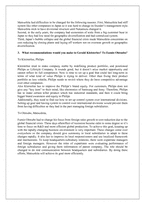Philips & Matsushita
 등록일 / 수정일
등록일 / 수정일 페이지 / 형식
페이지 / 형식 자료평가
자료평가 구매가격
구매가격
- 2011.01.26 / 2019.12.24
- 7페이지 /
 docx (MS워드 2007이상)
docx (MS워드 2007이상) - 평가한 분이 없습니다. (구매금액의 3%지급)
- 800원
최대 20페이지까지 미리보기 서비스를 제공합니다.
자료평가하면 구매금액의 3%지급!
 1
1 2
2 3
3 4
4 5
5 6
6 7
7
추천 연관자료
- 목차
-
목 차
1. How did Matsushita succeed in displacing Philips as No. 1? What were its distinctive competence and incompetency?
2. What do you think of the change each company has made to date – the objectives, the implementation, the impact? Why is the change so hard for both of them?
[Philips]
Van Reimsdijk, Rodenberg and Dekker (1971 - 1987)
Van der Klug (1987 - 1991)
Timmer (1991 – 1996)
Boonstra (1996 – 2001)
Kleisterlee (2001 - )
[Matsushita]
Yamashita & Tanii(1982 - 1992)
Morishita(1993 - 1999)
Nakamura(2000 - 2005)
Ohtsubo(2006 - )
3. What recommendations would you make to Gerald Kleisterlee? To Eumio Ohtsubo?
To Kleisterlee, Philips
To Ohtsubo, Matsushita,
- 본문내용
-
2. What do you think of the change each company has made to date – the objectives, the implementation, the impact? Why is the change so hard for both of them?
Philips has set up its organization to change from national focused company to globally efficient company by adapting lots of traits to move forward product focused firm. It has been putting an effort to restructure its firm to downsize and get rid of inefficient business units. However, the process was not toward strategically considered decision which usually refers to revisiting core competence. Then deciding which division to eliminate comes next step. As of now, it somehow successfully finished its restructuring process but took long time to establish current system. It reveals that the change has not been always good change and it actually is pretty difficult to downsize whereas diversifying is easier choice.
Matsushita started from strongly product focused firm to achieve economic of scale and scope in its domestic market. Founder’s spirit to achieve outstanding production system has led to success in establishing efficient system. It helped firm to go global, however, international expansions has brought many different issues for Matsushita to overcome. Especially relationship between head quarters and subsidiaries was usually to-down decision making relationship which led to frequent conflicts between head quarters and subsidiaries. Technology transfer and respond to local needs were not sufficient enough. Firm has tried many different methods to overcome its product division focused structure to spread its system over globally. But its change did not necessarily meet local market needs. In addition, economic crisis on Japanese economy had huge negative impact for Japanese companies to downsize its firm size and restructure. Following summaries indicate more in detail about how CEOs of each companies at different era tried to transform its company.
[Philips]
Philips’s decentralization had started since 1919 when Philips broadened sales organization and product line. The Great Depression forced Philips to build local production facilities and
자료평가
-
아직 평가한 내용이 없습니다.
오늘 본 자료
더보기

최근 판매 자료
- 이마트 E-마트의 공급사슬관리 SCM
- 스포츠마케팅_프로스포츠 구단(축구, 야구, 농구, 배구 등)을 1개 선정하여 해당 구단을 SWOT분석하여 다른 구단에 대한 경쟁전략을 수립하라 (3)
- [가치사슬, 경영전략] 가치사슬분석
- [마케팅] 아름다운 재단 SWOT 분석 및 개선 방안
- [광고홍보조사 설문지] 숙취해소음료의 제품과 광고에 대한 이미지
- [설문지] 기능성음료에 대한 마케팅 조사 설문지
- [국제기술이전] 국제기술이전의 개념과 효과, 특성(특징), 국제기술이전 구조와 경로
- [경제이론사] 빅토리아시대와 경제학의 지하세계
- [호텔경영조직] `Ritz Carlton` 리츠칼튼호텔 조직도 분석
- [조직행동론]서울 `리츠칼튼호텔`의 조직관리 프로그램 및 내부마케팅 분석
저작권 관련 사항 정보 및 게시물 내용의 진실성에 대하여 레포트샵은 보증하지 아니하며, 해당 정보 및 게시물의 저작권과 기타 법적 책임은 자료 등록자에게 있습니다. 위 정보 및 게시물 내용의 불법적 이용, 무단 전재·배포는 금지됩니다. 저작권침해, 명예훼손 등 분쟁요소 발견시 고객센터에 신고해 주시기 바랍니다.









